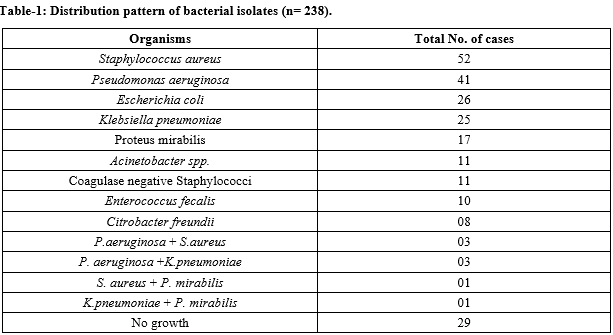A study of wound infections and its antibiogram in surgical intensive care unit of a tertiary care hospital
Abstract
Background: Wound infections can be caused through two major sources: exogenous and endogenous bacteria. The probability of wound infection largely depends on the patients systemic host defenses, local wound conditions and microbial burden. Despite modern surgical techniques and the use of antibiotic prophylaxis, Surgical Site Infection (SSI) is one of the most common complications encountered in surgery. SSI places a significant burden on both the patient and health system. SSI is thus a major cause of morbidity, prolonged hospital stay and increased health costs. Objective of this study was to identify and isolate various bacteria from wound infections in a surgical intensive care unit and to study their antibiogram.
Methods: Two wound swabs were collected from the wound and from a drop of aspirate, smear was made on clean glass slide and Gram staining was done for direct microscopic examination under oil immersion 100X objective to know various morphological types of bacteria and presence or absence of inflammatory cells. Second swab/drop of aspirate was used for culture by inoculating it on routine media like Blood Agar, Nutrient Agar and Mac Conkeys agar, incubated at 37° C for 24 hours aerobically.
Result: Out of 238 pus samples, 209 (88.6%) were culture positive for bacterial growth and no growth was observed in 29(12.4%) cases. Out of 209 bacterial culture positive cases, 201 were monobacterial and 8 were poly bacterial. Out of 201 bacterial isolates; S. aureus (56/26.6) was the commonest followed by P. aeruginosa (47/22.4%).
Conclusion: The study concludes that variety of aerobic bacteria is responsible for wound infection with predominance of Staphylococcus aureus followed by Pseudomonas aeruginosa
Downloads
References
2. Patricia Tille Text book of Diagnostic Microbiology, Bailey and Scott’s. Thirteenth Edition Pg 961-970.
3. Lauwers S, de Smet F. Surgical site infections. Acta Clin Belg. 1998;53(5):303-10.
4. Culbertson Wr, Altemeier Wa, Gonzalez Ll, Hill Eo. Studies on the epidemiology of postoperative infection of clean operative wounds. Ann Surg. 1961;154:599-610. doi:10.1097/00000658-196110000-00010
5. M Olson, MO’ Connor, ML Schwartz. Surgical wound infections. of 5 year prospective study of 20, 193 wounds at Minneapolis Va Medical Centre. Ann Surg, 1984;199(3):253-259.
6. Dellinger, E.P in Sabiston, D.C, Lyerly, K. (Eds) Textbook of Surgery, 18th Edn. WB Saunders Company, Philladilphia, PP-264-280.
7. Forber BA, Salm DF, Weissfiled Diagnostic Microbiology. In Bailey and Scott’s, 13th edition; Missiouri, Mosby Elsevier, 1998.
8. Washington CW, Stephen DA, William M, Elmer WK et al. In Koneman’s Colour atlas and text book of microbiology. 6th ed; Philadelphia; Lippincotts Williams and Walkins’ 2006; 68-74.
9. Clinical and Laboratory Standard Institute, Performance Standards for antimicrobial susceptibility testing, twenty third informational supplement, M100-S24. 2017;(34):50-57.
10. Miles RS, Anyes SGB. Laboratory Control of antimicrobial therapy, in General Colle J, Barrie P, Andrew GF, Anthony S, editors. Mackie and Mc Cartney Practical Medical Microbiology; 14th edition; New Delhi; 2007, 151-178.
11. Malik S, Gupta A, Singh KP, Agarwal J, Singh M. Antibiogram of aerobic bacterial isolates from post-operative wound infections at a tertiary care hospital in India. J Infect Dis Antimicrob Agents. 2011;28(1):45-51.
12. Afroz Z, Metri CB, Jyoti P. Bacteriological Profile and Antimicrobial Susceptibility Pattern of Skin and Soft Tissue Infections among Gram Negative Bacilli in a Tertiary Care Hospital of South India. J. Pharm. Sci Res.2015:7(7);397-400.
13. Rao R, Sumathi S, Anuradha K, Venkatesh D, Krishna S. Bacteriology of postoperative wound infections. Int J Pharm Biomed Res. 2013;4(2):72-6.
14. Sowmya N, Savitha S, Mallure S, Mohanakrishnan K, Sumathi G, Arumugam P. A two year study of spectrum of bacterial isolates from wound infections by aerobic culture and their antibiotic pattern in a tertiary care center. Int J Curr Microbiol App Sci. 2014;3(8):292-5.
15. Mehta VJ, Pandya JM, Mehta SJ. Surveillance of Post Operative wound infections in a Teaching Hospital, Gujarat. Int J Res Med. 2013;2(4):77-9.
16. Naik G, Deshpande S. A study on surgical site infections caused by Staphylococcus aureus with a special search for methicillin-resistant isolates. J Clin Diagn Res. 2011;5(3):502-8.
17. Suryawanshi P, Khan AQ, Saiyyad Altaf G, Patil A. Analysis of Organisms Found at Incision Site Intra-Operatively and its Implications with Post-Operative infections. Int J Sci Res Pub. 2014:67.
18. N Anbumani, J Kalyani, M Mallika. Prevalence of methicillin resistant Staphylococcus aureus in a tertiary referral hospital in Chennai, South India. Ind J Pract Doc 2006:48(4);191-195.
19. Rajaduraipandi K, Mani KR, Panneerselvam K, Mani M, Bhaskar M, Manikandan P. Prevalence and antimicrobial susceptibility pattern of methicillin resistant Staphylococcus aureus: a multicentre study. Indian J Med Microbiol. 2006;24(1):34-8. doi: 10.4103/0255-0857.19892
20. Anupurba S, Sen MR, Nath G, Sharma BM, Gulati AK, Mohapatra TM. Prevalence of methicillin resistant Staphylococcus aureus in a tertiary referral hospital in eastern Uttar Pradesh. Indian J Med Microbiol. 2003;21(1):49-51.
21. Shriyan A, Sheetal R, Nayak N.Aerobic micro-organisms in Post-Operative wound infections and their Antimicrobial suspceptibility Patterns. J Clinic Diagnos Res. 2010:4;3392-3396.
22. Javed FS, Reazvanian M, Kumar S, Norouzi H. Microbiological study of diabetic foot ulcer in an Indian Tertiary Care Hospital. Int J Life Sci and Review 2015;1(2):65-70.
23. Jeena Amatya, Manish Rijal and Reena Baidya. Bacteriological study of the Post Operative wound samples and antibiotic susceptibility pattern of the isolates in B&B Hospital Lalitpur Nepal. JSM Microbiology 2015, 3(1):1019.
24. Rai S, Yadav UN, Pant ND, Yakha JK, Tripathi PP, Poudel A, et al. Bacteriological Profile and Antimicrobial Susceptibility Patterns of Bacteria Isolated from Pus/Wound Swab Samples from Children Attending a Tertiary Care Hospital in Kathmandu, Nepal. Int J Microbiol. 2017;2017:2529085. doi: 10.1155/ 2017/2529085. Epub 2017 Mar 6.



 OAI - Open Archives Initiative
OAI - Open Archives Initiative


